ICT Project Management Report: Project Life Cycle and PRINCE2
VerifiedAdded on 2021/04/24
|7
|1357
|41
Report
AI Summary
This report delves into the realm of ICT Project Management, offering a comprehensive overview of key methodologies and concepts. It begins by defining project methodology as a five-phase process, emphasizing the importance of planning, execution, and closure. The report then proceeds to compare and contrast two prominent methodologies, PRINCE2 and PMBOK, highlighting their similarities in project handling and providing techniques, while also pointing out differences in output provision, guidelines, and project control. Finally, the report establishes a clear relationship between PRINCE2 and the project life cycle, emphasizing the methodology's staged approach and systematic processes. The report stresses the significance of PRINCE2 in reducing project risk and complexity while maintaining cost-effectiveness. The report provides a robust foundation for understanding project management principles.
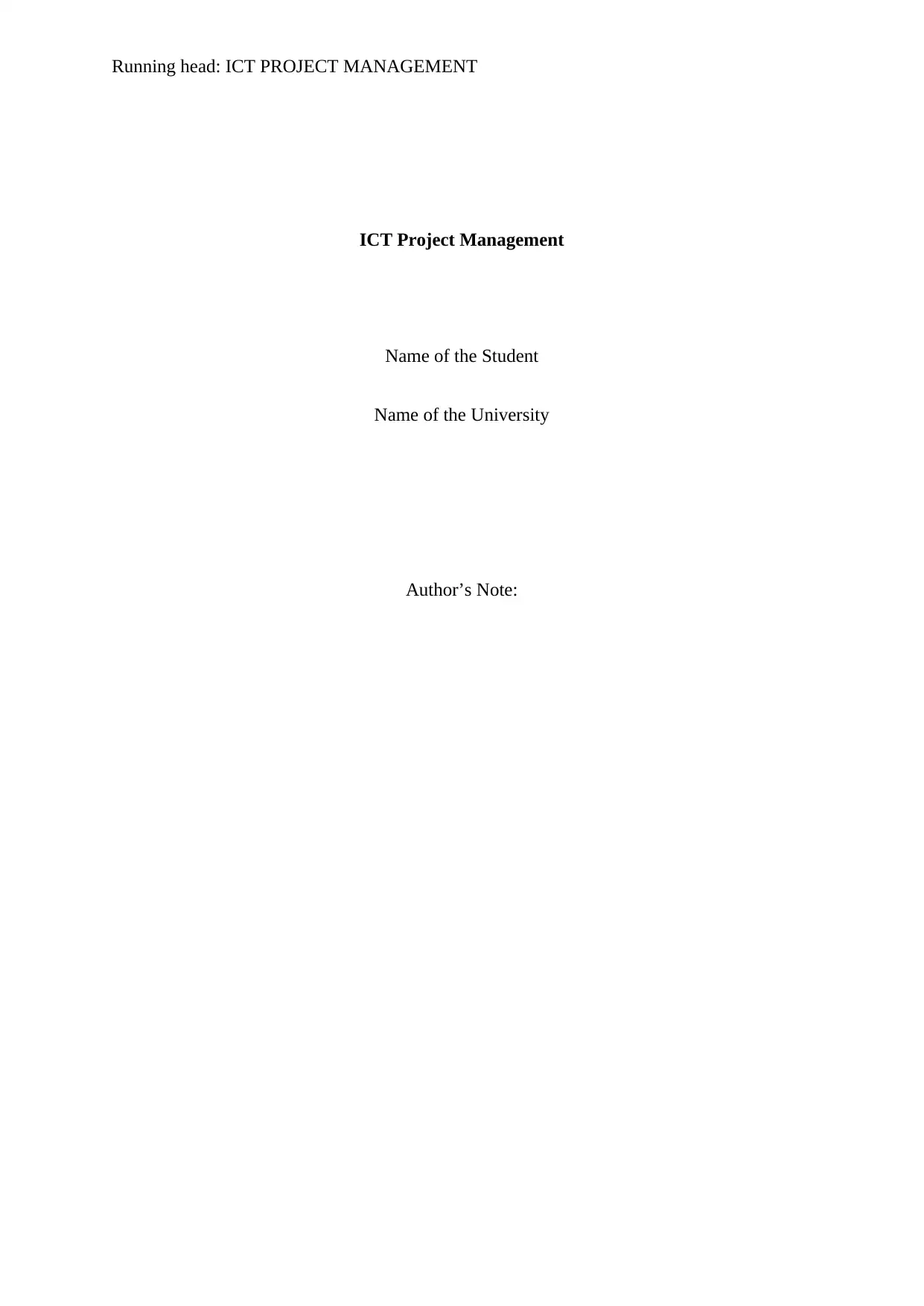
Running head: ICT PROJECT MANAGEMENT
ICT Project Management
Name of the Student
Name of the University
Author’s Note:
ICT Project Management
Name of the Student
Name of the University
Author’s Note:
Paraphrase This Document
Need a fresh take? Get an instant paraphrase of this document with our AI Paraphraser
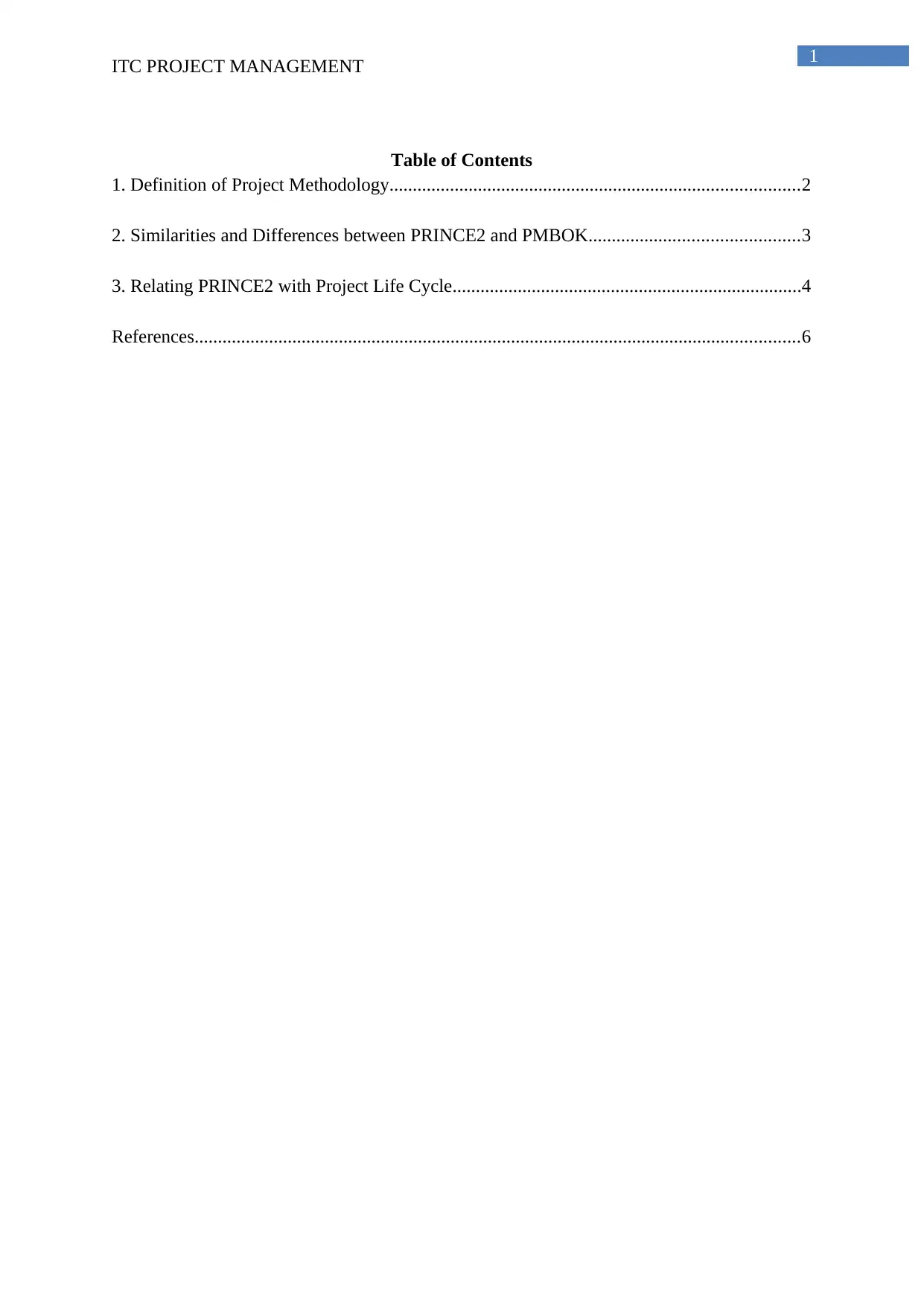
1
ITC PROJECT MANAGEMENT
Table of Contents
1. Definition of Project Methodology........................................................................................2
2. Similarities and Differences between PRINCE2 and PMBOK.............................................3
3. Relating PRINCE2 with Project Life Cycle...........................................................................4
References..................................................................................................................................6
ITC PROJECT MANAGEMENT
Table of Contents
1. Definition of Project Methodology........................................................................................2
2. Similarities and Differences between PRINCE2 and PMBOK.............................................3
3. Relating PRINCE2 with Project Life Cycle...........................................................................4
References..................................................................................................................................6
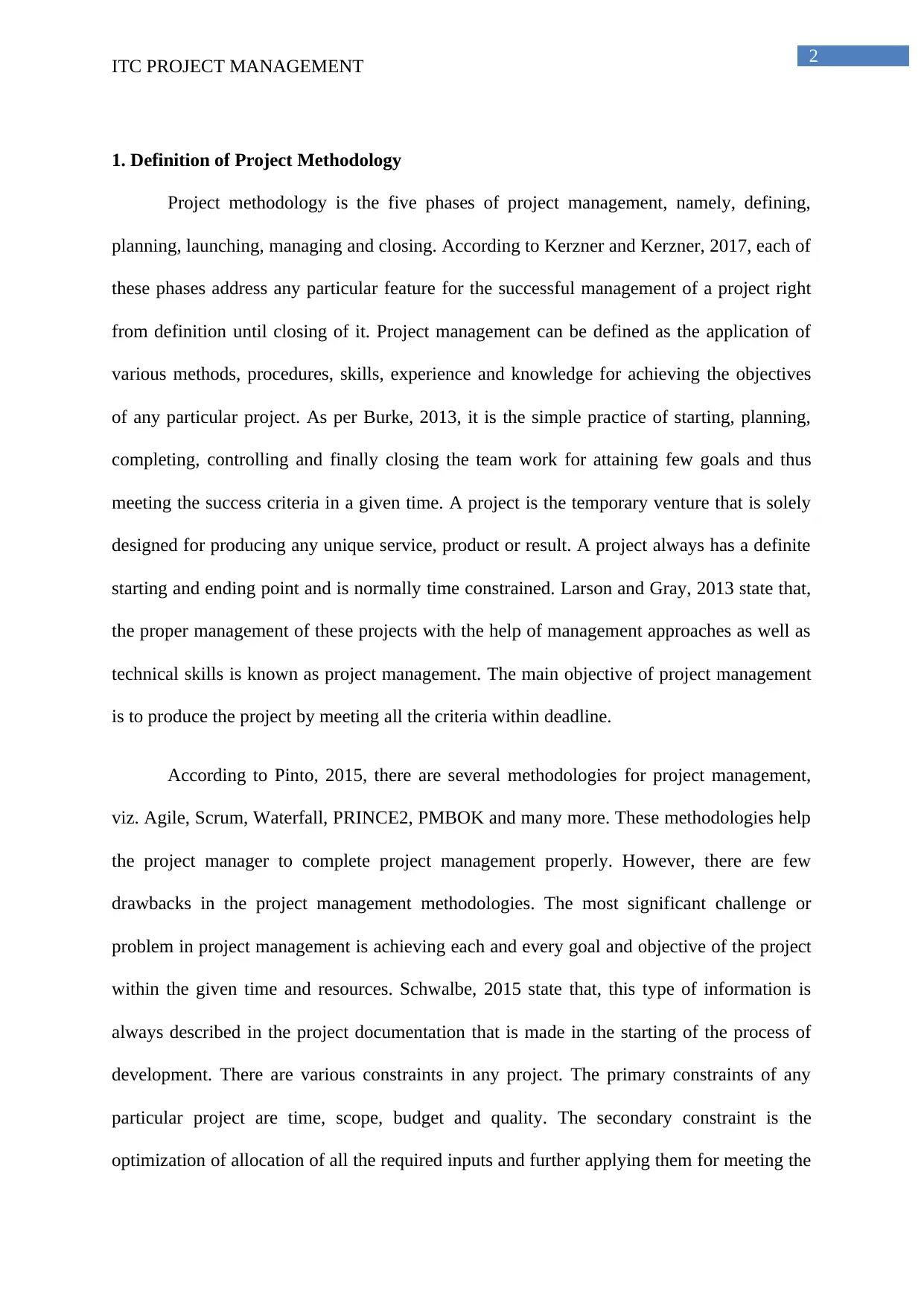
2
ITC PROJECT MANAGEMENT
1. Definition of Project Methodology
Project methodology is the five phases of project management, namely, defining,
planning, launching, managing and closing. According to Kerzner and Kerzner, 2017, each of
these phases address any particular feature for the successful management of a project right
from definition until closing of it. Project management can be defined as the application of
various methods, procedures, skills, experience and knowledge for achieving the objectives
of any particular project. As per Burke, 2013, it is the simple practice of starting, planning,
completing, controlling and finally closing the team work for attaining few goals and thus
meeting the success criteria in a given time. A project is the temporary venture that is solely
designed for producing any unique service, product or result. A project always has a definite
starting and ending point and is normally time constrained. Larson and Gray, 2013 state that,
the proper management of these projects with the help of management approaches as well as
technical skills is known as project management. The main objective of project management
is to produce the project by meeting all the criteria within deadline.
According to Pinto, 2015, there are several methodologies for project management,
viz. Agile, Scrum, Waterfall, PRINCE2, PMBOK and many more. These methodologies help
the project manager to complete project management properly. However, there are few
drawbacks in the project management methodologies. The most significant challenge or
problem in project management is achieving each and every goal and objective of the project
within the given time and resources. Schwalbe, 2015 state that, this type of information is
always described in the project documentation that is made in the starting of the process of
development. There are various constraints in any project. The primary constraints of any
particular project are time, scope, budget and quality. The secondary constraint is the
optimization of allocation of all the required inputs and further applying them for meeting the
ITC PROJECT MANAGEMENT
1. Definition of Project Methodology
Project methodology is the five phases of project management, namely, defining,
planning, launching, managing and closing. According to Kerzner and Kerzner, 2017, each of
these phases address any particular feature for the successful management of a project right
from definition until closing of it. Project management can be defined as the application of
various methods, procedures, skills, experience and knowledge for achieving the objectives
of any particular project. As per Burke, 2013, it is the simple practice of starting, planning,
completing, controlling and finally closing the team work for attaining few goals and thus
meeting the success criteria in a given time. A project is the temporary venture that is solely
designed for producing any unique service, product or result. A project always has a definite
starting and ending point and is normally time constrained. Larson and Gray, 2013 state that,
the proper management of these projects with the help of management approaches as well as
technical skills is known as project management. The main objective of project management
is to produce the project by meeting all the criteria within deadline.
According to Pinto, 2015, there are several methodologies for project management,
viz. Agile, Scrum, Waterfall, PRINCE2, PMBOK and many more. These methodologies help
the project manager to complete project management properly. However, there are few
drawbacks in the project management methodologies. The most significant challenge or
problem in project management is achieving each and every goal and objective of the project
within the given time and resources. Schwalbe, 2015 state that, this type of information is
always described in the project documentation that is made in the starting of the process of
development. There are various constraints in any project. The primary constraints of any
particular project are time, scope, budget and quality. The secondary constraint is the
optimization of allocation of all the required inputs and further applying them for meeting the
⊘ This is a preview!⊘
Do you want full access?
Subscribe today to unlock all pages.

Trusted by 1+ million students worldwide
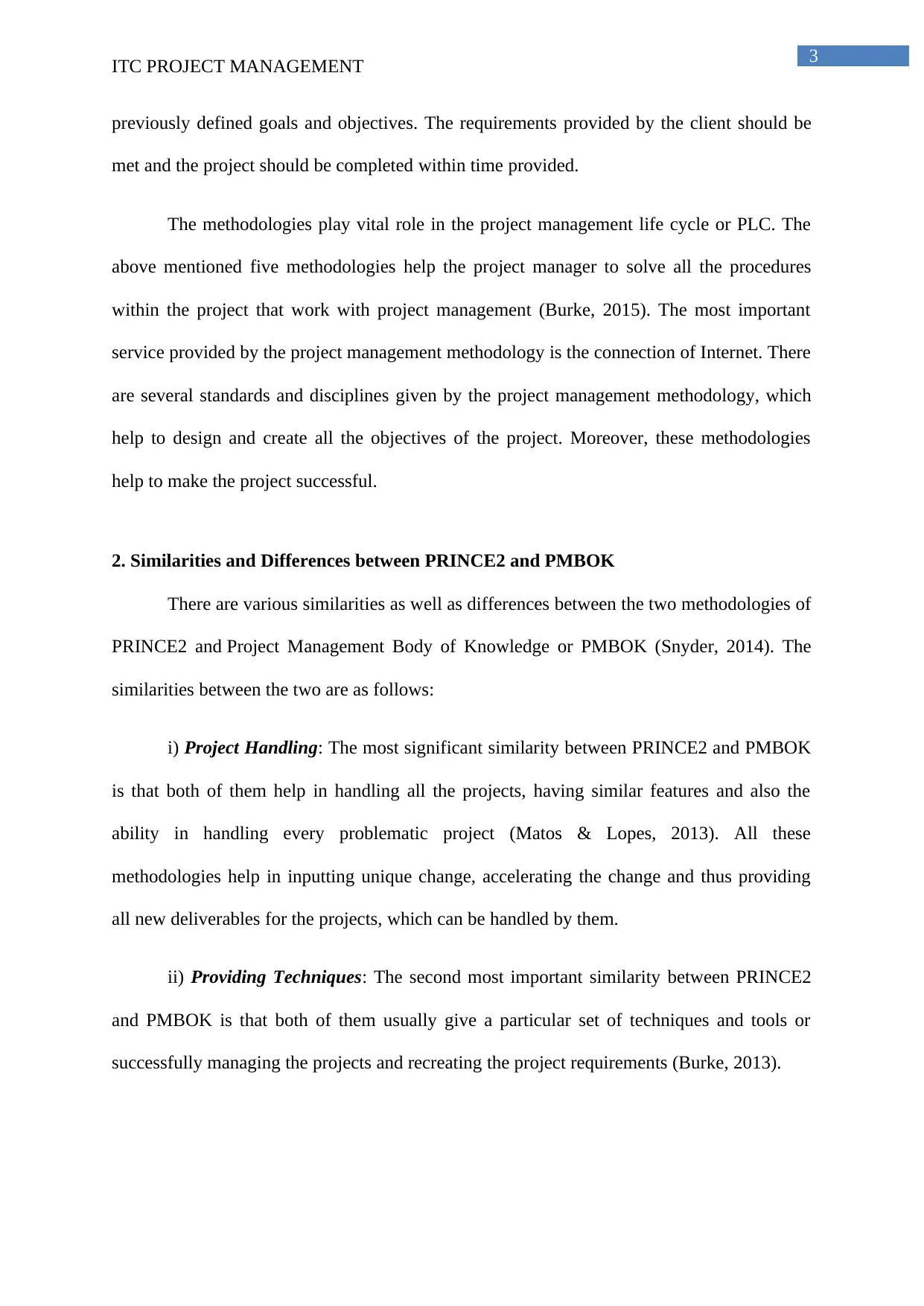
3
ITC PROJECT MANAGEMENT
previously defined goals and objectives. The requirements provided by the client should be
met and the project should be completed within time provided.
The methodologies play vital role in the project management life cycle or PLC. The
above mentioned five methodologies help the project manager to solve all the procedures
within the project that work with project management (Burke, 2015). The most important
service provided by the project management methodology is the connection of Internet. There
are several standards and disciplines given by the project management methodology, which
help to design and create all the objectives of the project. Moreover, these methodologies
help to make the project successful.
2. Similarities and Differences between PRINCE2 and PMBOK
There are various similarities as well as differences between the two methodologies of
PRINCE2 and Project Management Body of Knowledge or PMBOK (Snyder, 2014). The
similarities between the two are as follows:
i) Project Handling: The most significant similarity between PRINCE2 and PMBOK
is that both of them help in handling all the projects, having similar features and also the
ability in handling every problematic project (Matos & Lopes, 2013). All these
methodologies help in inputting unique change, accelerating the change and thus providing
all new deliverables for the projects, which can be handled by them.
ii) Providing Techniques: The second most important similarity between PRINCE2
and PMBOK is that both of them usually give a particular set of techniques and tools or
successfully managing the projects and recreating the project requirements (Burke, 2013).
ITC PROJECT MANAGEMENT
previously defined goals and objectives. The requirements provided by the client should be
met and the project should be completed within time provided.
The methodologies play vital role in the project management life cycle or PLC. The
above mentioned five methodologies help the project manager to solve all the procedures
within the project that work with project management (Burke, 2015). The most important
service provided by the project management methodology is the connection of Internet. There
are several standards and disciplines given by the project management methodology, which
help to design and create all the objectives of the project. Moreover, these methodologies
help to make the project successful.
2. Similarities and Differences between PRINCE2 and PMBOK
There are various similarities as well as differences between the two methodologies of
PRINCE2 and Project Management Body of Knowledge or PMBOK (Snyder, 2014). The
similarities between the two are as follows:
i) Project Handling: The most significant similarity between PRINCE2 and PMBOK
is that both of them help in handling all the projects, having similar features and also the
ability in handling every problematic project (Matos & Lopes, 2013). All these
methodologies help in inputting unique change, accelerating the change and thus providing
all new deliverables for the projects, which can be handled by them.
ii) Providing Techniques: The second most important similarity between PRINCE2
and PMBOK is that both of them usually give a particular set of techniques and tools or
successfully managing the projects and recreating the project requirements (Burke, 2013).
Paraphrase This Document
Need a fresh take? Get an instant paraphrase of this document with our AI Paraphraser
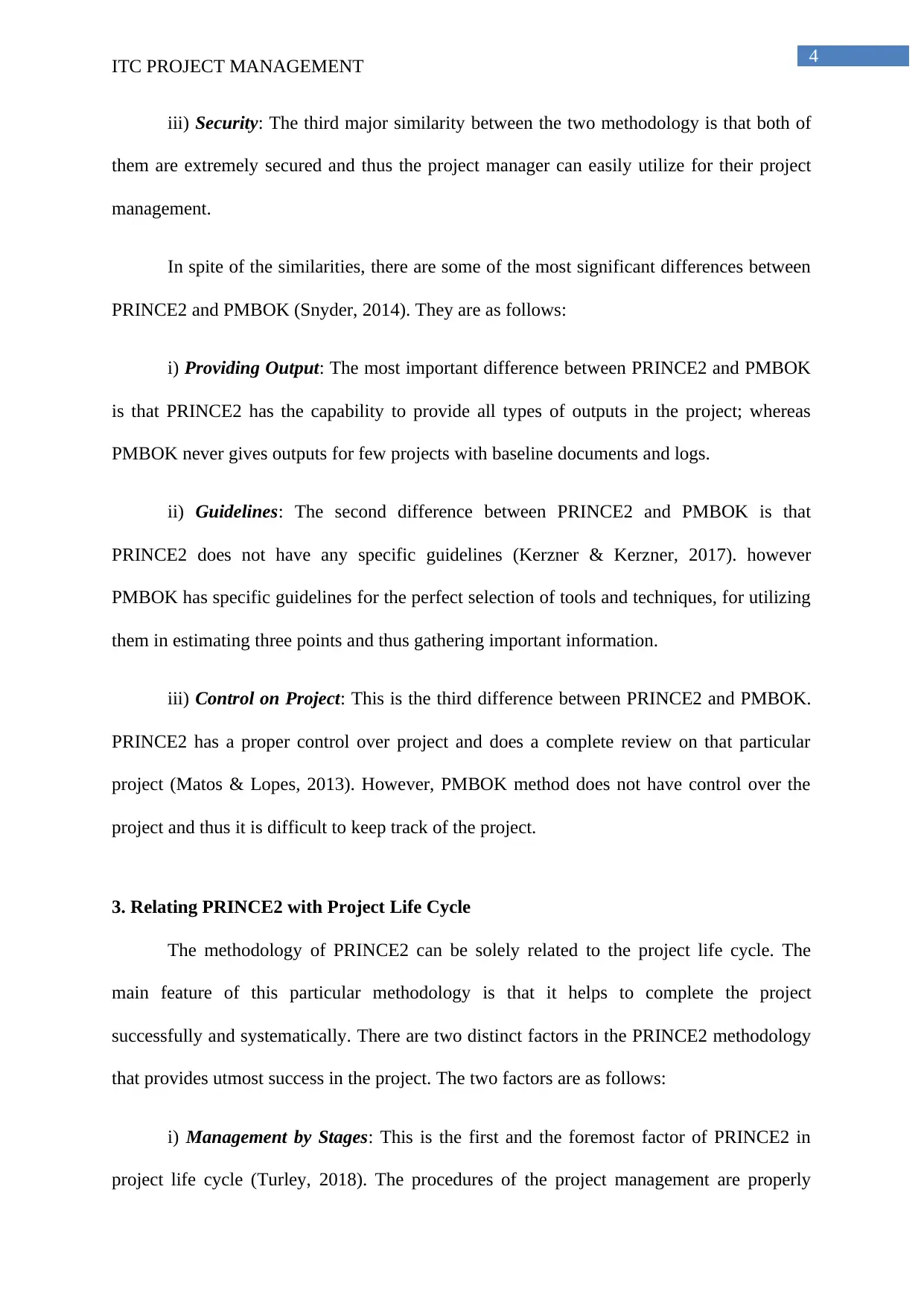
4
ITC PROJECT MANAGEMENT
iii) Security: The third major similarity between the two methodology is that both of
them are extremely secured and thus the project manager can easily utilize for their project
management.
In spite of the similarities, there are some of the most significant differences between
PRINCE2 and PMBOK (Snyder, 2014). They are as follows:
i) Providing Output: The most important difference between PRINCE2 and PMBOK
is that PRINCE2 has the capability to provide all types of outputs in the project; whereas
PMBOK never gives outputs for few projects with baseline documents and logs.
ii) Guidelines: The second difference between PRINCE2 and PMBOK is that
PRINCE2 does not have any specific guidelines (Kerzner & Kerzner, 2017). however
PMBOK has specific guidelines for the perfect selection of tools and techniques, for utilizing
them in estimating three points and thus gathering important information.
iii) Control on Project: This is the third difference between PRINCE2 and PMBOK.
PRINCE2 has a proper control over project and does a complete review on that particular
project (Matos & Lopes, 2013). However, PMBOK method does not have control over the
project and thus it is difficult to keep track of the project.
3. Relating PRINCE2 with Project Life Cycle
The methodology of PRINCE2 can be solely related to the project life cycle. The
main feature of this particular methodology is that it helps to complete the project
successfully and systematically. There are two distinct factors in the PRINCE2 methodology
that provides utmost success in the project. The two factors are as follows:
i) Management by Stages: This is the first and the foremost factor of PRINCE2 in
project life cycle (Turley, 2018). The procedures of the project management are properly
ITC PROJECT MANAGEMENT
iii) Security: The third major similarity between the two methodology is that both of
them are extremely secured and thus the project manager can easily utilize for their project
management.
In spite of the similarities, there are some of the most significant differences between
PRINCE2 and PMBOK (Snyder, 2014). They are as follows:
i) Providing Output: The most important difference between PRINCE2 and PMBOK
is that PRINCE2 has the capability to provide all types of outputs in the project; whereas
PMBOK never gives outputs for few projects with baseline documents and logs.
ii) Guidelines: The second difference between PRINCE2 and PMBOK is that
PRINCE2 does not have any specific guidelines (Kerzner & Kerzner, 2017). however
PMBOK has specific guidelines for the perfect selection of tools and techniques, for utilizing
them in estimating three points and thus gathering important information.
iii) Control on Project: This is the third difference between PRINCE2 and PMBOK.
PRINCE2 has a proper control over project and does a complete review on that particular
project (Matos & Lopes, 2013). However, PMBOK method does not have control over the
project and thus it is difficult to keep track of the project.
3. Relating PRINCE2 with Project Life Cycle
The methodology of PRINCE2 can be solely related to the project life cycle. The
main feature of this particular methodology is that it helps to complete the project
successfully and systematically. There are two distinct factors in the PRINCE2 methodology
that provides utmost success in the project. The two factors are as follows:
i) Management by Stages: This is the first and the foremost factor of PRINCE2 in
project life cycle (Turley, 2018). The procedures of the project management are properly

5
ITC PROJECT MANAGEMENT
managed by stages. It is nearly impossible to manage the project without proper planning. In
case of bigger projects, handling cannot be done without steps. Thus, the project processes
are segregated in stages for systematic handling.
ii) Processes: Since the beginning of the project with the methodology of PRINCE2,
usually three processes can be executed out of the seven procedures, included in this
particular methodology (Turley, 2018).
These above mentioned factors clearly depict the importance and value of the
methodology of PRINCE2 in project management. PRINCE2 is extremely important and
significant for any project as it helps to reduce the risk as well as complexity of the project.
moreover, this methodology is cost effective and thus all project managers can easily afford
them.
ITC PROJECT MANAGEMENT
managed by stages. It is nearly impossible to manage the project without proper planning. In
case of bigger projects, handling cannot be done without steps. Thus, the project processes
are segregated in stages for systematic handling.
ii) Processes: Since the beginning of the project with the methodology of PRINCE2,
usually three processes can be executed out of the seven procedures, included in this
particular methodology (Turley, 2018).
These above mentioned factors clearly depict the importance and value of the
methodology of PRINCE2 in project management. PRINCE2 is extremely important and
significant for any project as it helps to reduce the risk as well as complexity of the project.
moreover, this methodology is cost effective and thus all project managers can easily afford
them.
⊘ This is a preview!⊘
Do you want full access?
Subscribe today to unlock all pages.

Trusted by 1+ million students worldwide

6
ITC PROJECT MANAGEMENT
References
Burke, R. (2013). Project management: planning and control techniques. New Jersey, USA.
Kerzner, H., & Kerzner, H. R. (2017). Project management: a systems approach to planning,
scheduling, and controlling. John Wiley & Sons.
Larson, E. W., & Gray, C. (2013). Project management: The managerial process with MS
project. McGraw-Hill.
Matos, S., & Lopes, E. (2013). Prince2 or PMBOK–a question of choice. Procedia
Technology, 9, 787-794.
Pinto, J. K. (2015). Project management: achieving competitive advantage. Prentice Hall.
Schwalbe, K. (2015). Information technology project management. Cengage Learning.
Snyder, C. S. (2014). A guide to the project management body of knowledge: PMBOK (®)
guide. Project Management Institute: Newtown Square, PA, USA.
Turley, F. (2018). PRINCE2® Foundation Training Manual. Van Haren.
ITC PROJECT MANAGEMENT
References
Burke, R. (2013). Project management: planning and control techniques. New Jersey, USA.
Kerzner, H., & Kerzner, H. R. (2017). Project management: a systems approach to planning,
scheduling, and controlling. John Wiley & Sons.
Larson, E. W., & Gray, C. (2013). Project management: The managerial process with MS
project. McGraw-Hill.
Matos, S., & Lopes, E. (2013). Prince2 or PMBOK–a question of choice. Procedia
Technology, 9, 787-794.
Pinto, J. K. (2015). Project management: achieving competitive advantage. Prentice Hall.
Schwalbe, K. (2015). Information technology project management. Cengage Learning.
Snyder, C. S. (2014). A guide to the project management body of knowledge: PMBOK (®)
guide. Project Management Institute: Newtown Square, PA, USA.
Turley, F. (2018). PRINCE2® Foundation Training Manual. Van Haren.
1 out of 7
Related Documents
Your All-in-One AI-Powered Toolkit for Academic Success.
+13062052269
info@desklib.com
Available 24*7 on WhatsApp / Email
![[object Object]](/_next/static/media/star-bottom.7253800d.svg)
Unlock your academic potential
Copyright © 2020–2025 A2Z Services. All Rights Reserved. Developed and managed by ZUCOL.




